Stand at the foot of Capitol Hill and look westward from the intersection of Maryland Ave. and 3rd St., S.W. The National Museum of the American Indian looms ahead, like a massive natural stone formation from the American West.
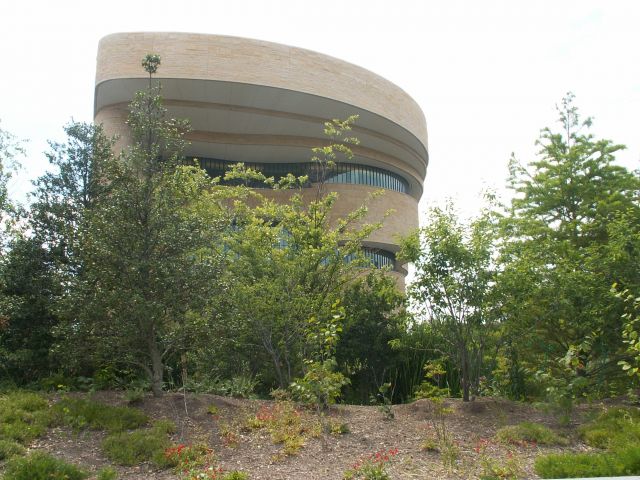
Approach the east entrance, and you will pass landscaped pools, plants and rocks. The Museum’s walls of rough-surfaced stone glow with a yellow, earthy tone. The building’s curved, shelving overhang suggests a mesa, shaped by wind and water. This impression is no accident. The building and its setting consciously reflect both the natural and spiritual heritage of Native Americans – as home to the world’s largest collection of Native American cultural displays. The Museum opened on September 21, 2004, feted with ceremonies, greeted by a 20,000-strong procession of Native Americans, and lauded with speeches and intense national press coverage. The structure itself met with widespread architectural praise. Entirely overlooked amid these celebrations was a very different addition to the city’s exhibits. Outside its doors, the Museum offers a new and striking paleontological display: stone surfaces rich in trace fossils from life in an ancient sea. Look at the surface of the pale stone panel protruding slightly from the wall, about thirty feet to the left of the main entrance doors.
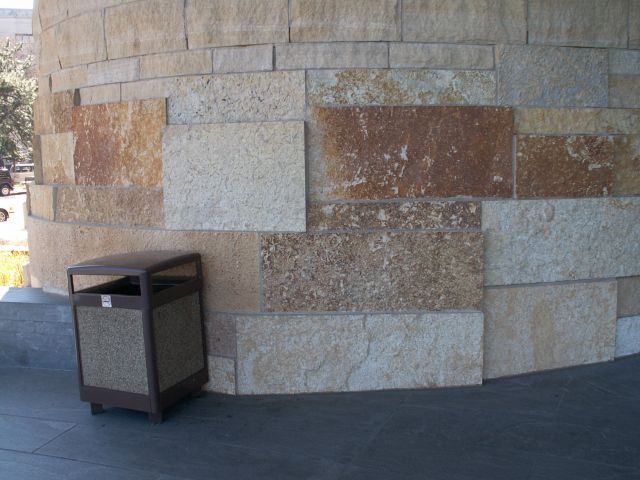
This panel is crisscrossed with dozens of winding, raised forms that suggest a bas relief of worms.
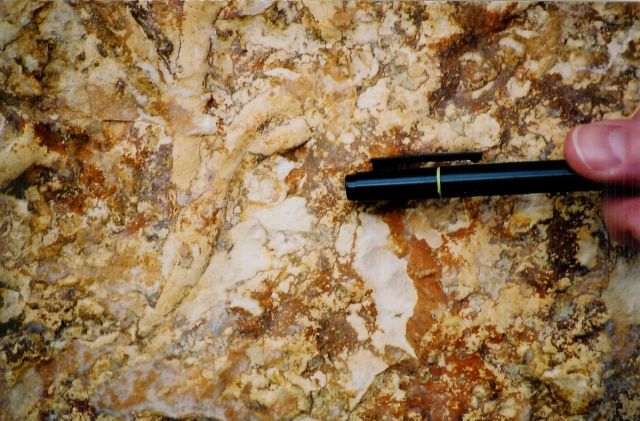
The tubular, spaghetti-like features are burrows left by invertebrates as they moved through the calcium-rich mud of a sea covering southeastern Minnesota nearly 480 million years ago, during the early Ordovician period. These burrows can be seen at many points as you walk around the museum, particularly on the western end.
The Fossils
Other areas of the Oneonta Formation have yielded fossil shells and other hard remains – cephalopods (squid-like animals), brachiopods (clam-like animals), gastropods and trilobites. Only trace fossils remain occur in the panels of this stone here, however. Trace fossils are tracks or disturbances caused by animals in sediments and ultimately in the resulting stone formations. They can be quite spectacular – dinosaur footprints are trace fossils. These trace fossils have their own interesting features.
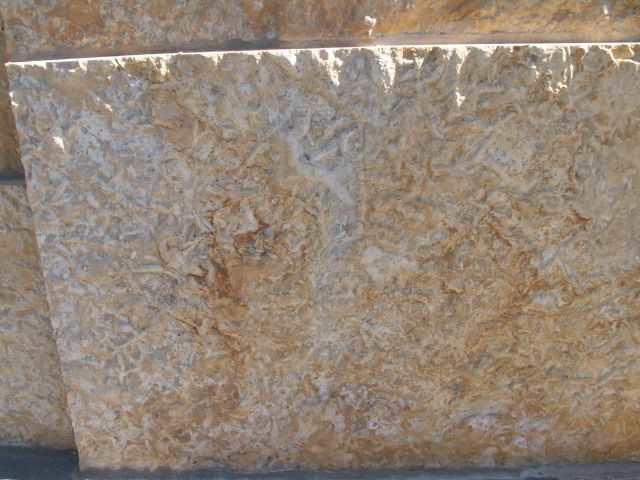
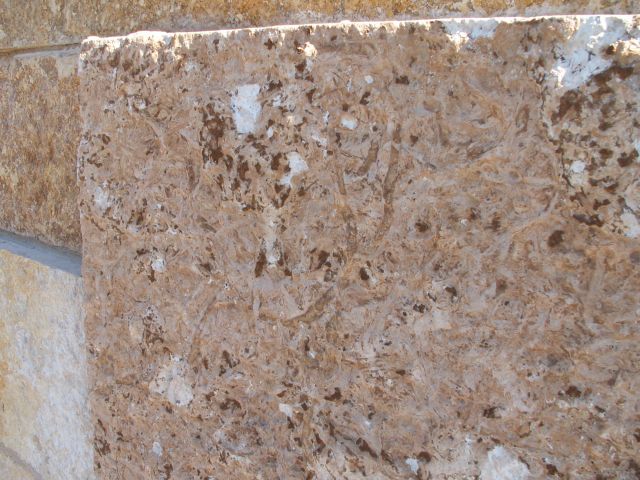
The phrase, “worm borrows” comes to mind at the sight of the winding shapes. Despite much research, however, paleontologists do not know the exact nature of the animals that left these fossilized burrows. Scientists are reasonably certain that the tube-like patterns reflect the paths taken by organisms that churned their way through the mud of the sea floor. They were likely arthropods, but what type, and whether they were even another type of animals, is difficult to deduce from the traces. Another geological feature is vividly apparent on the stone. Although the stone surface of the building is virtually new, many rust-colored, or purple-black patches or films appear on the surface.
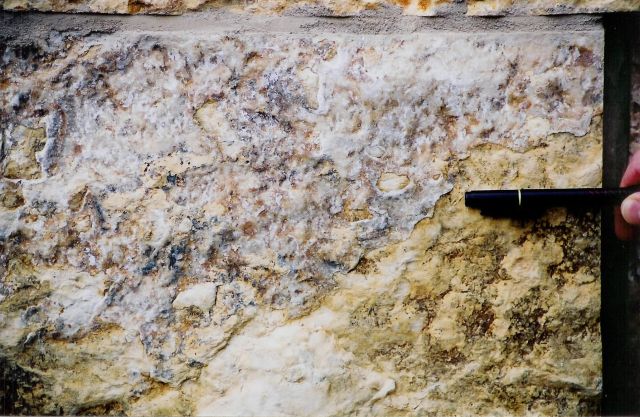
These patches may seem to suggest possible biological activity, and “thrombolites,” or clotted stone fabrics reflecting fossilized microbial activity, are sometimes found in this stone. However, the discolored incrustations on the surfaces of the Museum are probably not related to thrombolites. Instead these features likely resulted from secondary cements of calcite or quartz that accumulated within the dolostone long after the sediments were deposited.
The Kasota Limestone and the Environment of Minnesota in the Early Ordovician
The Kasota Limestone, or “Kasota Stone,” as it is known commercially, is extracted from quarries near the town of Kasota, Minnesota, along the Mississippi River. It is cut from the Oneonta Formation, also called the Oneonta Dolostone. This formation is a relatively dense stone formation that extends across much of the central part of North America. It varies between 45 and more than 300 feet in thickness. The Kasota Stone is a dolostone because a significant portion of its crystals are composed of calcium magnesium carbonate, rather than the calcium carbonate that makes up proper limestones. The presence of the calcium magnesium carbonate makes the dolostone harder than most limestones, and contributes to its commercial attractiveness as a building stone. The Oneota Formation was deposited during the early Ordovician period, about 480 million years ago. In the Minnesota of that period, a sandy tropical seashore bordered a large, shallow sea that covered much of North America, 10° to 40° south of the equator. The Minnesota Geological Survey has compared the shoreline of the time to “the sandy shore of the Gulf of Mexico, but with a barren, mostly lifeless land surface.” Land plants had not evolved, so terrestrial life was probably limited to primitive algae and bacteria. During the course of the Ordovician, the sea levels rose and fell, but the Oneota Formation was probably deposited in reasonably deep water.
About the Building
The Museum represents a departure from the modern or neoclassical designs commonly seen in Smithsonian museums on the Mall. An article in American Antiquities summarized the process leading to this unique design:
“Beginning in the 1990s, consultations began with Indians throughout the Western Hemisphere about how to present the stories and customs of their communities in a way that highlighted how Native Americans perceive their place in the universe, spiritually, historically and physically. What emerged was a living museum, close to nature, whose design reflects the solar calendar and equinoxes with an eastern orientation and entrance.”
Noted architects of Indian heritage contributed, particularly the Canadian architect Douglas Cardinal (of Blackfoot heritage), and many others, including consultants whose backgrounds included the Cherokee, Choctaw, Hopi, Navajo and Oneida nations. The resulting building successfully achieved its goal of evoking “images of a wind-swept mesa.” The structure is surrounded by symbolism. Forty so-called “Grandfather Rocks,” quarried in Canada and sent to D.C. after a special ceremony of the Montagnais First Nations group, surround the Museum. Four cardinal direction markers are present from the far reaches of Indian communities. The vegetation on the north and east sides of the structure was carefully chosen to reflect varying environments of the Native American peoples – hardwood, native crops, and wetlands. The eastern doorway, so different than the Mall-oriented entrances of the other museums, faces the rising sun. Its pavement reflects the celestial configuration on the date that legislation was introduced to create the Museum. Inside and outside, the Museum design is infused with symbolic meaning.
Given the careful reflection of American Indian themes in the architecture, why do the walls display fossils? Are they symbolic too? The author has not yet encountered any reference to the fossil-bearing nature of the Kasota stone in the literature of the building. There seems to be no specifically American Indian symbolism in the presence of fossils, as such. The stone appears to have been chosen primarily for its naturalistic color and texture. As the National Geographic article stated, the “rough stone” cladding near the ground on the exterior, would offer “a distinctly natural texture in the areas where visitors are most likely to touch the building.” However, the architects knew that the stone would display visible fossils. Prior to the selection of dimension stone for the building, architectural team members traveled to Minnesota to see the stone in place and visit the quarry and its operators. There, the presence of fossils came up in discussions. The architects felt that the presence of fossils could add to the visitor’s sense of being in the presence of a natural rock formation. Unfortunately, none of the current literature mentions the fossils, and surely few visitors recognize them independently. The fossil presence in the stone is, at most, a very secondary consideration. Thus, the Museum’s walls provide another gallery in the Accidental Museum of Paleontology.
Acknowledgments and Sources
Special thanks to Anthony Runkel, Chief Geologist of the Minnesota Geological Survey, for his generous contribution of information, research sources, and for his review of the fossil discussion and of the fossil pictures.
Identification. The author learned from a Smithsonian staff member that Dr. Kenneth Rasmussen, a professor of geology at Northern Virginia Community College, was seen examining the stone closely during opening day festivities. Dr. Rasmussen confirmed via e-mail that the exterior stone was full of trace fossils, thus prompting the author to undertake further research.
Information about the Oneota formation, its fauna and the paleoenvironment. Personal communication, Anthony Runkel, Minnesota Geological Survey. “The Paleozoic and Related Rocks of Southeastern Minnesota, by Clifford R. Stauffer and George A. Thiel, University of Minnesota, Minnesota Geological Survey Bulletin 29 (1941), at pp. 55-59. Pamphlet, Minnesota at a Glance, “Ancient tropical seas – Paleozoic History of Southeastern Minnesota,” by A.C. Runkel, University of Minnesota, Minnesota Geological Survey (2000).
Pamphlet, Minnesota at a Glance, “Fossil Collecting in the Twin Cities Area,” by J. Mossier and S. Benson, University of Minnesota, Minnesota Geological Survey (1995, rev. 1999).
Information about the selection of the Kasota Stone and the architecture of the Museum. Personal communication, Duane Blue Spruce, of the National Museum of the American Indian, regarding the selection of the Kasota Stone and the architects’ visit to Minnesota.
Other information about the building design is from: “National Museum of the American Indian Opened in September 2004,” American Antiquities website, http://www.americanantiquities.com/articles/article14.html;“National Museum of the American Indian Takes Rightful Place on the Mall,” by Stephanie Stubbs, AIArchitect,http://www.aia.org/aiarchitect/thisweek04/tw0934/0924nmai.html; “Building a Native Place,” NMAI in Washington, DC, Architectural Highlights/Architectural Facts, http://www.mnai.si.edu/subpage.cfm?subpage=dc&second=building&third=architect; “20,000 American Indians March at National Museum Opening,” by Stefan Lovgren, September 21, 2004, National Geographic News,http://news.nationalgeographic.com/news/2004/09/0914_090915_indian_museum_opening…; and “New National Indian Museum Is Native by Design,” National Geographic News,http://news.nationalgeographic.com/news/2004/09/0914_040913_american_indianmuseu…,
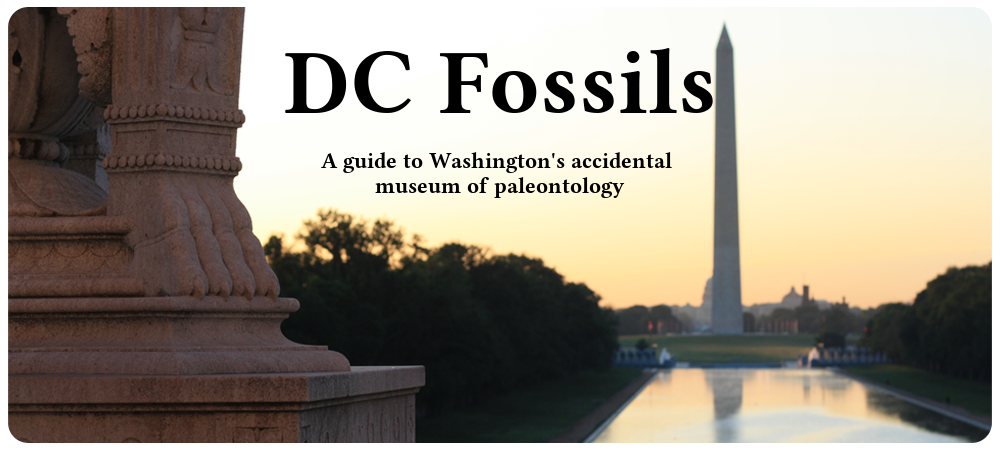
Hi, this is a comment.
To get started with moderating, editing, and deleting comments, please visit the Comments screen in the dashboard.
Commenter avatars come from Gravatar.